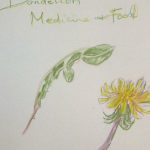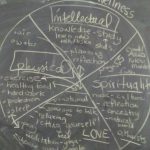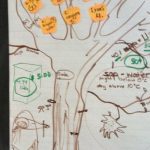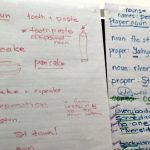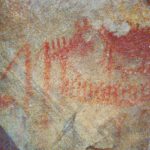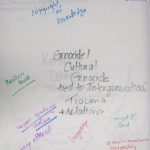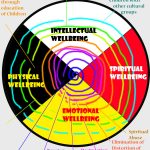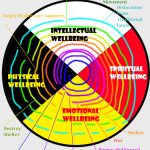In our project, we sought to develop as professionals in terms of our understanding of traditional Indigenous knowledge focusing on Anishinabe (Algonguin, Ojibwe) and Metissage traditional knowledge. We sought to be more informed about how our well-being as educators as well as that of our adult learners can be balanced. We considered how this can be done through the connection to traditional knowledge, world views of Indigenous peoples, connection to the traditional territory we live and work on (Algonquin), and approaches to education that are holistic in nature. Holistic models of well-being and pedagogy were considered along with the guidance of four elders and one board employee who is involved in Indigenous education. Our team also looked at existing frameworks and samples from the fields of Culturally Relevant Indigenous Education and First Nations, Métis and Inuit Student Success. We are creating lessons for newcomer adults who are from diverse ethnicities, religions, races and genders. These lessons promote well-being as understood by the ancestral traditions of the Anishinabeg of this land on which we live and teach. The lessons are aimed at learners in ESL AO – EO and will include broad-based literacy activities that have levelled readings suited to the diversity of understandings of the clientele we serve, as well as listening, writing and oral activities that reinforce approaches to teaching ELLs. We have looked at the literature of several Indigenous authors and are incorporating poetry, short stories, non-fiction articles, oral stories and non-fiction into our courses. We focused on how the wellness models could be emphasized while reinforcing the ESL Course expectations. We are also trying to start to use some of the CRIE approaches into our classroom practice in order to promote the well-being of our learners.
Team Members
Margaret Boyle
Ottawa-Carleton District School Board
Igor Tesanovic
Ottawa-Carleton District School Board
Colin Finlayson
Ottawa-Carleton District School Board
Professional Learning Goals
- Deepened our understanding of the Anishinabeg whose territory we live on
- Deepened our understanding of traditional knowledge of the Algonquin, emphasizing wellness, oral storytelling and holistic values of knowledge and wellness
- Developed holistic approaches to introducing newcomers to this territory (the traditional unceded territory of the Algonquin nation) to Algonquin oral history, approaches to oral stories and holistic wellness
- Created competency in creating wellness-focused lessons that incorporate broad-based literacy approaches for each of the ESL courses we teach in order to create lessons that utilize the holistic approach to Indigenous traditional ways of teaching and pedagogical approaches that are informed by Culturally Responsive Indigenous Education
Activities and Resources
Activities:
As well as meeting as a team to discuss the project and first steps, we made contact with elders and community resource people who are Anishinabeg (Algonquin and Ojibwe/Chippewa) and Métis. We met with or had circles with Annie Smith St. Georges, Robert St. Georges and Vincent Kicknosway (Cultural Liaison for Odawa Native Friendship Centre), and we will meet with Kris Meawasige (OCDSB) and Albert Dumont in June. Some topics that elders and community resource persons discussed include:
- Algonquin territory and how to acknowledge the unceded territory on which we teach
- Well-being and medicine wheel teachings
- Traditional life, life on the reserve and life in the city occupying Anishinabeg territory
- Roles elders are called to take on in the urban Indigenous community such as doing openings as an Algonquin elder at government events, the role of the elder for the National Arts Centre and the new Indigenous theater program at the NAC proposed by the elder 20 years ago
- The importance of giving thanks to and acknowledging Mother Earth, and the importance of prayer in one’s life
- Personal struggles and challenges one elder dealt with as consequences of Canada’s residential schools system
- Personal achievements of one elder after he decided to live life in a good way (Mino Pimimadiziwin)
- Preservation, continuation and strengthening of cultural awareness through one’s own children
- The meaning of carrying an eagle feather
- The meaning behind the different sacred items Anishinabeg might carry (sweet grass, tobacco)
- The importance of the grandfather/grandmother teachings of the Anishinabeg: respect, honesty, bravery, humility, truth, and wisdom
- The power of Indigenous medicine and medicine wheels
As a team, we chose curriculum structures and CRIE pedagogical approaches in order to build and teach units using literature written by Indigenous authors for the levels of ESL that we currently teach:
- ESLAO/BO: The Red Sash by Jean E. Pendziwol – This is a children’s book which will be used in conjunction with the teachings of the medicine wheel (i.e., self, family, community and the natural worlds)
- ESLBO, ESL DO, EPS 30: The Maple Leaves of Kichi Makwa by Albert Dumont – This book features short stories and poetry on themes of the maple tree (BO), pine tree, birch tree and forest. It will be used in conjunction with both medicine wheels we considered.
- ESLDO: I am Algonquin by Rick Revelle
One team member attended an OSSTF-sponsored PD Day which was organized by the First Nations, Métis and Inuit Subject Council, titled “Hands- On Reconciliation” and another team member was one of the organizers. This richly diverse PD event included a keynote address and performance by the TR1BE Academy, a session on traditional Indigenous medicine with Marlene Souliere, the importance of taking care of the land as the land gives us medicine, and a session with Kris Meawasige on the use of the talking circle in our classrooms. Also there was a resource and crafts trade fair.
We met with Albert Dumont who will come as a guest presenter to share his knowledge and the power of poetry and prose with the students on June 6 in ESL BO and ESL DO courses.
Kris Meawasige who will facilitate a sharing circle with a class in June was also contacted.
Resources:
- Learning directly through oral language from community elders and knowledge keepers
- The Red Sash by Jean E. Pendziwol
- The Maple Leaves of Kichi Makwa by Albert Dumont
- I am Algonquin by Rick Revell
- Of Trees and Their Wisdom: Poetry and Short Stories by Albert Dumont
- The Sacred Tree: Reflections on Native American Spirituality by Phil Lane Jr., Judie Bopp, Michael Bopp, Lee Brown and elders
- Pearson’s Post Secondary Module on First Nations, Métis and Inuit Student Success
- Aboriginal Youth Re-engagement Officer (OCDSB)
- PD Day resources
- Ottawa Aboriginal Coalition report to the Aboriginal Community Forum, February 2018
- Diagrams of medicine wheels
The following PD resources were provided by the team leader:
- Samples of lesson template
- Reading on traditional teaching methods and history of First Nations education in Canada
- Intergenerational trauma
- Cultural genocide
- Indian education for Indian children
- Native teacher education movement
- Overview of Culturally Responsive Indigenous Education
- Traditional knowledge in the curriculum
- Learning from the land
- Spirituality in education
- Learning through Indigenous language
- Authenticity of teaching resources
- Diversity of cultural practises
- First Nations learning styles
- Teaching with oral language
- Teaching in circles
- Experiential learning
- Time for thinking
- Involvement or role models
- Integrative learning
- Multiple literacies
- Sample of a CRIE lesson plan and handouts
- Diagrams of cultural genocide and genocidal history in North America
- Medicine wheel teachings orally with diagrams of two of the many diverse wheels:
1. Our Relations – Kakina ni Dodem – Self, Family, Community and the Natural World and the importance of Mino Pimidiziwan (living in a good way) which encompasses knowledge of each of these directions, as well as an understanding our responsibilities to others and self for wellness.
2. Balance in Life – Mino Mishkiki (good medicine) which fundamentally enables a teacher or student to reflect on the balance of well-being of spirit, emotions, and physical and intellectual directions.
- Sample lessons that are structured around traditional knowledge
Unexpected Challenges
All activities were helpful and some were more relevant to our direct goals than others. Our projects original intentions changed somewhat due to scheduling and availability of both team members and elders to being less focused on Algonquin knowledge and more on Indigenous knowledge in general. We still focused on well-being and the team leader provided professional development and so we met our goal with a somewhat modified focus.
Enhancing Student Learning and Development
One of the first tangible products of this project was the fact that we as a school have been able to start acknowledging the territory on which we live, after our consultation with a number of elders. We have started using an announcement each day of being on Algonquin unceded territory and have started to prepare a support package for teachers to explain the significance of this daily statement. The hope is that most teachers in the school will take the time to explain the origin, significance and value of territory acknowledgement.
Another tangible product is that we have started to develop lesson plans, handouts and other resources to support student wellness based in the ITK (Indigenous Traditional Knowledge) that the elders made us aware of. For example, students in some classes will be meeting with an Algonquin elder in June. He is one of the writers we are using in newly created ESL BO and DO literature units.
As well as the package on Algonquin territory, we have started to create course-specific lessons that utilize Indigenous models of wellness, Culturally Responsive Indigenous Education models, and pedagogies from the Indigenous Student Success field.
ESLAO/BO and The Red Sash (summary):
In this unit, we will explore the traditional Indigenous medicine wheel of relationships through the short story, The Red Sash. We focus on the medicine wheel that explores all our relations by knowing Self and our relations with Family, Community and the Natural World. The Red Sash is a Métis story about a young man and his relationship with himself, his family and his community as he is challenged by the forces of nature. The story is a great fit for this particular medicine wheel, and a great introduction to it. Students explore the following:
- Indigenous presence in Canada (the fact that there are many Indigenous peoples who live in different parts of the country, with their distinct and diverse cultural practices and languages), including the Métis Nation
- The Medicine Wheel: All Our Relations (how to talk about the medicine wheel, and the importance of balance and responsible connection to others)
- The elements of the story (the language, vocabulary, basic literary devices)
- Connections to the students – a summative project will focus on the individual student and how their lifestory may fit in the medicine wheel in question – how do they understand themselves, family, community and the natural world
ESLBO and writings by Algonquin elder Albert Dumont (summary):
In this unit, we have explored the traditional medicine wheels of Relations and of balance, as well as implementing known Indigenous pedagogical approaches. This unit’s theme is the maple tree. It starts with a short story that is analyzed in a literary sense and also in how it introduces students to some key Anishinabeg values and terms. Next students read a non-fiction article about how a new product “Maple Water” is actually a traditional Anishinabeg medicine. They are introduced to how maple sap, syrup and sugar are made. They also explore other traditional and modern uses of maple wood. The third activity has students go outside in small groups and identify maple trees and collect both a leaf and a seed. Students then go home and tell another person how to identify this tree. Students are then introduced to oral storytelling and how circles are done. Students hear a story and draw a picture of it, and the next day write a version of the story in their own words scaffolded by reflective questions and a story outline that emphasizes the understanding of plot in narrative. Students learn about pictographs of the Anishinabeg, as well as other writing systems of Indigenous nations of North America and learn vocabulary related to how the pictographs support the retention of oral memory within nations. Students will also be reading a children’s book by Albert Dumont, as well as poetry. Each lesson is integrative in nature and culturally authentic.
As well as the professional development activities and their potential impact on Indigenous education, we sense that this has developed enthusiasm and awareness amongst newcomer adult learners to want to know more about Indigenous nations of North America, and the diversity of expressions of Indigeniety that can be found in the writings of First Nations, Inuit and Métis authors.
Sharing
This project will be shared with other ESL teachers in particular those teaching the courses we developed lessons for. Our PD committee plans to have Indigenous topics for next year’s PD sessions and we are hosting an adult education symposium so we will consider providing professional development for our colleagues as well as others next year. Also we may consider presenting at an ESL or FNIM Subject Council PD Day. The most ideal format for sharing resources and lessons is via a Google Site and we already have a Google Folder we can share with colleagues in our own school. Also we are considering having an Indigenous-focused activity at some staff meeting.
Project Evaluation
In our project, we met all goals and anticipate building towards a more full and rich implementation of these goals in future semesters. We can determine success through the students’ interest in the topics we are covering, and in our own conversations within our team and with colleagues, as well as our reflection on wellness and Indigenous pedagogical models. Also our observations in class, and the sharing of new ideas and development of relevant and culturally authentic resources, as well as students’ work in a portfolio of samples are all how we anticipate continuing to assess how this project has met our initial goals.
Resources Used
Resources from Tungasuvvingat Inuit was used in the project in the first PD session.
The Provincial Subject Association for teachers of First Nations, Métis and Inuit Studies and Indigenous languages is welcoming to all teachers interested in culturally authentic education. It has many great resources we considered.
The International Fund for Animal Welfare’s Northern Dog Curriculum Project was a source of some information adapted for the teacher PD session resources.
The Algonquin Way Cultural Centre near Pikwakanagan, Anishinabeg is a centre that has online resources for teaching about the Algonquins of Eastern Ontario. There are lessons, and an online glossary of Anishinabemowin words and other resources.
Interview with Algonquin author, Rick Revelle.
https://www.dundurn.com/news/interview-rick-revelle-author-i-am-algonquin
Newspaper article about Algonquin author, Rick Revelle.
http://www.thewhig.com/2015/10/08/revelle-writes-about-his-algonquin-roots
A brief overview of the multiple intelligences theory, originally published by Howard Gardner in 1983. It supports the need for diverse approaches to teaching all learners including Indigenous adults and ELLS who are newcomers to Canada.
Dumont, Albert, et al. AninaÌTigo-AniÌBiÌShan Kichi-Makwang = The Maple Leaves of Kichi Makwa = Les Feuilles D’eÌRable De Kichi Makwa. Turtle Moons Contemplations, 2011.
This children’s picture book by an Algonquin elder and author is trilingual in Algonquin, English and French and is being used in the ESL BO.
Dumont, Albert. Of Trees and Their Wisdom: Poetry and Short Stories. Turtle Moons Press, 2009.
This book by Algonquin elder and author, Albert Dumont, has short stories and poetry. The book is organized in four themes: Maple, Birch, Pine and the Forest. It is used in the BO and DO courses.
Revelle, Rick. I Am Algonquin: An Algonquin Quest Novel. Dundurn, 2013.
This novel by an Algonquin author who is from Ardoch First Nation is used in the ESL DO course. See the unit plan and handouts that relate to it and other Indigenous literature.
Pendziwol, Jean E. and Debon, Nicolas. The Red Sash. Groundwood Books, 2017.
The Red Sash is a children’s picture book about a Métis family and is being used in ESL AO/BO combined courses.
Lane, Phil, et al. The Sacred Tree. Four Worlds International, 2012.
A reference for teachings that inform wellness in life, including medicine wheel teachings.
Landon, Rocky and MacDonald, David. A Native American Thought of It: Amazing Inventions and Innovations. Annick Press, 2008.
This book is a valuable resource in understanding key traditional knowledge and was used by the teacher of the ESL DO unit.
Amant, Deb St. First Nations, Métis, and Inuit Student Success. Pearson Canada, 2014.
This is from the Teacher Education Series by Pearsons Post Secondary and was written by an Indigenous educator in Ontario and co-ordinated with assistance of FNMIEO.
Switzer, Maurice. “We Found Somebody.”
This newspaper article by Nippissing First Nation writer was used in the ESL DO course.
This speech entitled “We Walked to Something” was by Joseph Boyden and is used in the ESL DO unit.
https://www.mheducation.ca/web_resources/sch/BOYDE_WALK_TO_MORNING.pdf
“An Uncertain Journey on a Jagged Road” by Forrest Rain Shapwaykeesic (a personal opinion) is used in the ESL DO course.
https://prezi.com/gqldhfhveuuf/an-uncertain-journey-on-a-jagged-road/
Mishenene, Rachel A., and Pamela Rose Toulouse. Strength and Struggle: Perspectives from First Nations, Inuit, and Métis Peoples in Canada. McGraw-Hill Ryerson, 2011. This book has many different forms of contemporary literature by Indigenous authors. We use this in several courses.
In ESL DO, we are using:
- “Waawaate Fobister: A Shining Star” by Lisa Charleyboy
- “An Afternoon in Bright Sunlight” by S. Bruised Head (short story)
- “3740166701” by John Adrian McDonald (poem)
- “The Amazing Sense of Shake” by Cherie Dimaline (short story)
- Of Trees and Their Wisdom: Poetry and Short Stories by Albert Dumont (assorted poems from the “Forest” section)
We used this curriculum guide from the MOE.
http://www.edu.gov.on.ca/eng/curriculum/secondary/esl912currb.pdf
This is Ontario First Nation, Métis and Inuit Education Policy Framework referred to in materials from the second PD session.
A copy of the document from the National Indian Brotherhood, published originally in 1972 is at this link. It was referred to in our second PD session.
This web link has several links to key government documents revelant to Indigenous education in Canada including the Report of the Truth and Reconciliation Commission (2015) and the Royal Commission on Aboriginal Peoples (1995), both relevant to Indigenous education.
https://www.aadnc-aandc.gc.ca/eng/1307458586498/1307458751962
This website has a search engine to search for images, films, etc. that are provided copyright-free by the creators or are in the public domain. It was used to find images for the handouts from ESL BO.
Resources Created
These resources will open in your browser in a new tab, or be downloaded to your computer.



